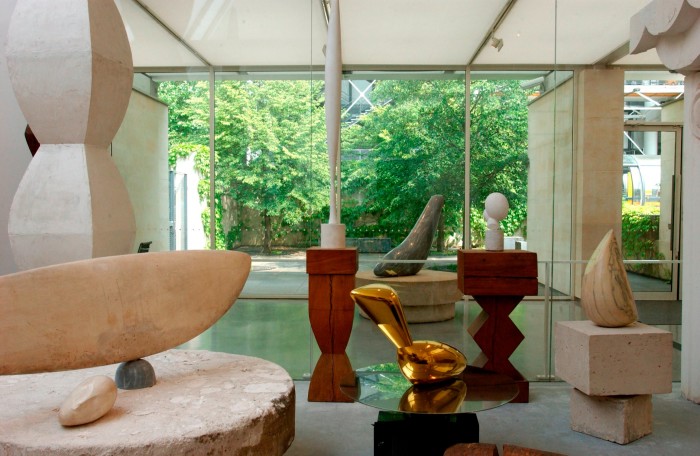This article is part of a guide to Paris from FT Globetrotter
Paris was the first place I ever visited outside of Israel, when I was just 15 years old. I was astonished to see streets that hadn’t changed for centuries, with carved Lutetian limestone, oxidised bronze ornamentation and weary cobbled pavements.
Coming from Jerusalem, where the only preserved architecture sites can be found in the old city or randomly merged with our modern mistakes, I loved discovering seemingly banal features such as cast-iron tree-guards and gargoyle heads as drain pipes. I remember being more impressed by the coherency of these urban details than the historical monuments themselves, as they were responsible for the wondrous continuum of the seamless Parisian cityscape.
When I look back over the past two decades I’ve now spent as a Parisian, what was so striking to me as a teen remains as potent and fascinating today. As a designer, these are the type of venues I return to again and again as touchstones, either for comfort, inspiration or joy. They are all around the heart of Paris, and some are more offbeat than others, though all have kept their timeless promise.
Place de Furstenberg
Rue de Furstemberg, 75006 Paris

Place de Furstenberg, one of the most charming squares in Paris, is found in the Left Bank neighbourhood of Saint-Germain-des-Prés. It is a truly magical place, with impressive paulownia trees and their giant leaves, hidden behind the Saint-Germain-des-Prés church, the oldest in Paris. (It is on the site of the first Saint-Germain abbey, which was destroyed by the Vikings and then rebuilt in the 10th century.)
The square epitomises the principle of “effortless chic”, a microcosm of balance and proportions. It is also makes a perfect departure point if ever you wish to stroll between the fabric stores of Rubelli, Pierre Frey and Loro Piana Interiors, or the intimate shops and galleries of Rue Jacob, Rue de Seine and further west on Rue de Lille. Directions
Yen
22 Rue Saint-Benoît, 75006 Paris


This was one of the first restaurants I ever experienced in Paris. It has become an institution of Japanese cuisine, using seasonal French ingredients with Japanese technique. Its minimalist interior and attentive service have not changed one bit in more than 20 years. There is a fascinating love affair between Parisians and Japanese cuisine — the city is awash with hotspots and “do not miss” places. Though Yen is not one of those: it’s rather an always reliable and never-compromising place. My enchantment with it lies in its simplicity and stability, the ingredients of a humble and quality-oriented institution. Enjoy the cold or hot soba noodles while looking out at Rue Saint-Benoît. Website; Directions
Deyrolle
46 Rue du Bac, 75007 Paris


Located near the Musée d’Orsay and the Musée Maillol, in the seventh arrondissement, Deyrolle, founded in 1831, was once the Parisian institute of natural sciences. Today it is a taxidermy shop and museum — a cabinet of curiosities with fossils, insect specimens, animals (bears, lions and zebras, for example) and bird species, such as swans and ostriches. During my 2003 internship at Edelkoort Studio, the trend forecasters, we would borrow items from Deyrolle for magazine shoots. It has since remained a source of inspiration for me and an up-close-and-personal point of reference for the natural world, a resource for scientists, artists and designers. I still remember hearing the terrible news of a fire there in 2008; many artists assisted in the reconstruction of this gem, such as Nan Goldin and Claude Lalanne, among others. Website; Directions
Atelier Brâncuși
Place Georges Pompidou, 75004 Paris

The Romanian sculptor Constantin Brâncuși lived and worked in Paris from 1904 until his death in 1957. In his will, he donated his art studio to the French state, and in 1997, Atelier Brâncuși — an exact reconstruction — was built just opposite the Pompidou Centre to house a collection of his works. With more than 100 sculptures, dozens of drawings and a vast array of other art, the atelier feels like a database of the language of forms and crafts, and a frozen moment in time. I often visit when I’m seeking inspiration in the realm of form-giving. Website; Directions
Square du Vert-Galant
Place du Pont Neuf, 75001 Paris

Square du Vert-Galant, in the 1st arrondissement, is probably the most central yet somewhat hidden location in Paris. This small triangular park, accessed via the Pont Neuf, was built in 1884 by joining two small islands to the larger Île de la Cité, the western island on the river Seine. The square is named after Henry IV, who was called the “Green Gallant” due to his numerous mistresses. A visit here offers the most privileged view of Paris, but it also surprisingly isolated, with its weeping willow tree that caresses the water of the Seine. I discovered it in my early years in Paris and still head there to gather my thoughts. What better place to do so than away from traffic, surrounded by water in a floating park in the very heart of the city. Directions
Raphael Navot is an award-winning interior designer and was named Designer of the Year 2023 by Maison&Objet. His latest project, Hôtel Dame des Arts, opens in February 2023
Which places epitomise Paris for you? Share them in the comments
Follow FT Globetrotter on Instagram at @FTGlobetrotter


